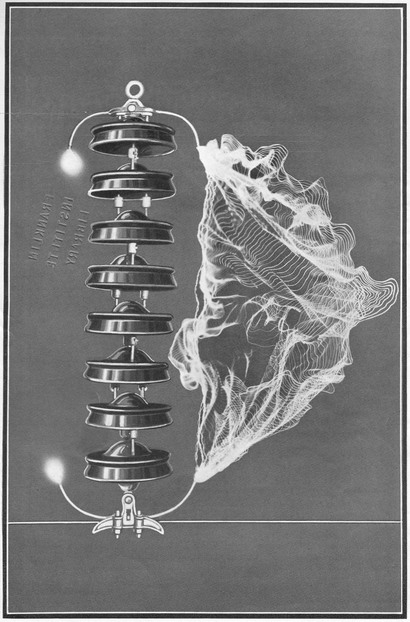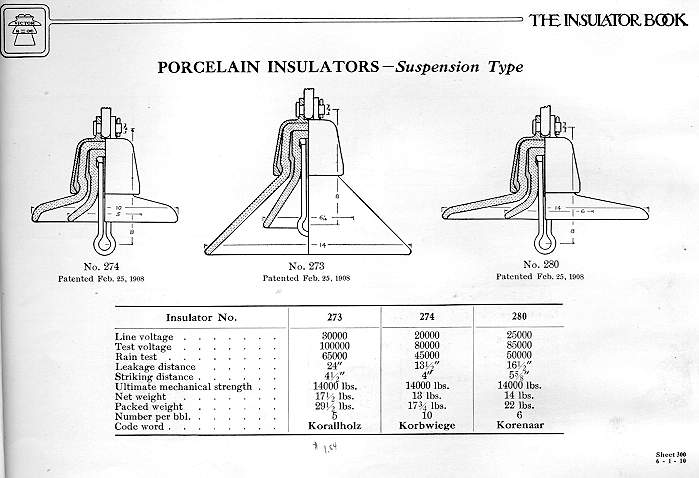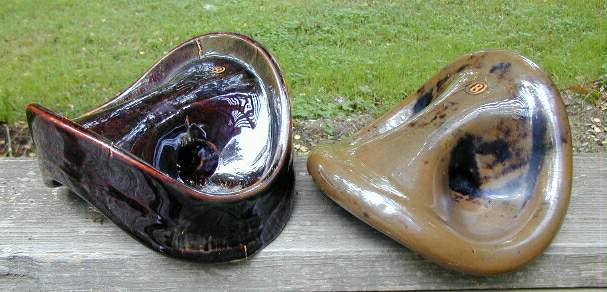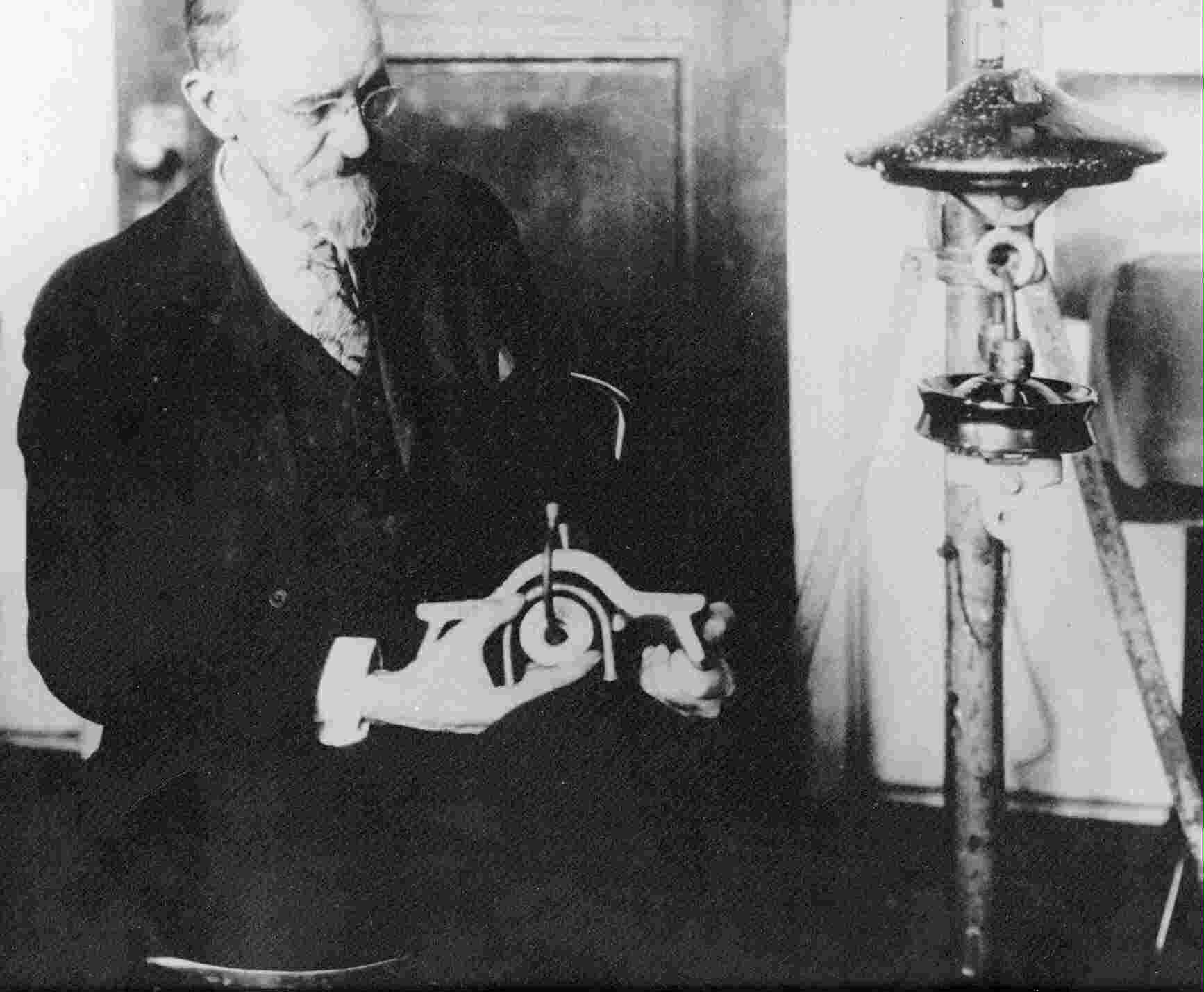
Hewlett Insulators
by Elton Gish
Page
1 Page 2 Page 3
Page 4 Page 5
The
Hewlett suspension disks were widely used across the country for several decades
and a few can still be found in service in remote areas.
The greatest advantage of this first practical suspension insulator was
the absence of any form of cement. In
contrast, the cap and pin suspension insulator required the use of Portland
cement to secure the metal cap on the top and the metal pin in the hole formed
on the underside. Early attempts at
making cap and pin suspension insulators met with limited success because the
weight and strain of the power line often pulled the metal parts off the
insulator and thermal expansion of the cement frequently caused the porcelain
body to crack and fail. Such
problems began to occur just a few years after installation.
The Hewlett insulator had none of these problems.
The major disadvantages of the Hewlett disk were complicated assembly,
gross weight of a completed string, and poor electrical properties which
resulted in radio interference. Later
improvements in the interconnecting hardware did make assembly easier.
The major advantage of the Hewlett insulator and its use as a suspension
system was allowing the power industry to break the 60,000 volt barrier imposed
by the use of multipart pin-type porcelain insulators.
The Hewlett suspension disk allowed construction of more efficient power
lines with voltages of 100,000 volts and higher. In the late 1910’s, the Hewlett was in such great demand
that two companies were granted licenses to produce insulators based on the
original General Electric patent.
In
July 1988, I took several photographs of an early installation of Hewletts at
Coal Bank Pass between Durango and Silverton, CO.
The photographs were on slides and I just recently had them converted
into prints. Two of the photographs
are shown in this column. Note the
very old wooden pole and the three strings of Hewletts with four insulators in
each string. The pole was used as a
corner support for a sharp turn in the 3-phase power line. Note, too, the metal arcing rings which helped prevent
damaging flashovers caused by wet weather or nearby lightning strikes.
A line crew would find access to these poles difficult because a bucket
truck would be out of the question in this very mountainous region.
That probably explains why these Hewlett strings have survived so long. I would bet that the line has now been upgraded.
Three
strings of four 10” Hewlett suspension insulators with arcing rings
used to support the strain
of the power line turning a sharp angle.
Location is Coal Bank Pass, CO in 1988.
The
first suspension insulator was patented by Fred Locke on January 10, 1905 (No.
779,659; see my book, Fred M. Locke: A Biography).
This design was rigid with the metal cap and pin either cemented or
screwed on the porcelain disk. Fred
Locke did develop other suspension insulator designs which were mostly
impractical because they were either too heavy, difficult to make, or
complicated to assemble. On October
18, 1910, Fred Locke was granted a patent for a suspension insulator similar to
the cap and pin disk which used eye hooks as connectors. The string of insulators was mounted between two crossarms
and the conductor was attached in the middle of the string.
This was not quite the suspension system that industry later accepted.
On February 25, 1908, John Duncan was granted a patent for a cap and pin suspension insulator that was composed of two porcelain shells cemented together. See the catalog page below from the 1910 Locke catalog. The three styles of Duncan's 2-part multipart suspension insulator had a high failure rate because of cement expansion and specimens today are considered very rare.

On
January 25, 1910, A. O. Austin was granted a patent for the first cap and pin
suspension insulator that used a ball and socket coupling.
The patent was assigned to Austin’s employer, Akron Hi-Potential
Porcelain Co., which was later purchased by the Ohio Brass Co. in August 1910.
The suspension disk with ball and socket coupling was shown in the July
1910 Ohio Brass catalog and this basic feature was
part of nearly every suspension insulator offered by O-B for many years.
A
French citizen named Charles Priestley took a different approach and obtained a
patent on October 1, 1912, for what we now call the “hog’s liver” or
“pork liver” insulator. The
insulator was composed of a pair of saddles disposed of each other with
interlocking grooves formed in the porcelain body to receive metal cables or
links (similar to the Hewlett). The
interlocking feature prevented the conductor from dropping to the ground if the
porcelain body was broken. The
Priestley patent application was filed on Dec. 20, 1910.
O-B licensed the Priestley patent and cataloged the insulator for many
years. It was not advertised as a
suspension insulator but rather as a Link Strain Insulator. O-B probably considered the link strain inferior to their cap
and pin insulators for suspension service and the interlocking configuration
proved important in strain services.
Ohio
Brass acquired the rights to the Priestley patent before the patent was granted
in 1912. The July 1910 and July
1911 O-B catalogs did not show the Priestley link strain insulator, but the 1912
O-B catalog did show it with the note “Patent Applied For”.
It offered the following description:
“This insulator is used for horizontal spans or dead-ending feeder
wires. The wire can be easily
threaded as the holes are practically straight.
The flanges not only increase the arcing distance, but also provide
additional protection in case of storms. In
case the insulator should be broken, the wire cannot fall as the loop of one
piece passes through the other.” The
working voltage of the link strain was listed as 11,000 volts.

Link Strain insulator shown in
Ohio Brass catalogs from 1912 (left) and 1919 (right).
Note the sharp flange edges on the earlier version and the more rounded
edges on the later version.
You can see the embossed O-B logo marking on each insulator.
Very rare pumpkin colored O-B link strain found by Robin Harrison and Ed Sewall in the northwest.
O-B
continued to catalog the link strain insulator as late as 1940 (apparently
discontinued in 1947 catalog). Note
that the illustration of the link insulator in the 1912 catalog has sharp flange
edges and the one in the 1919 catalog shows rounded edges.
The change to the rounded edge design occurred quickly as it was first
shown in the 1914 O-B catalog (I don’t have a copy of the 1913 catalog) and
continued without change until the link strain was discontinued.
Edward
Hewlett developed an insulator that utilized the same interlocking principle
embodied in the Priestley patent. Hewlett
was granted patent No. 1,110,934 on September 15, 1914.
The patent application was filed three years earlier than the Priestley
patent on April 30, 1907. The
patent was assigned to the General Electric Co. in Schenectady, NY.
The Hewlett was designed to be washed by rain to reduce contamination
effects, maintain a dry surface area to reduce electrical leakage, and be strong
enough to withstand great strains from the conductor.
The new insulator was announced by Hewlett in a paper he presented at the
AIEE annual conference in Niagara Falls on June 26, 1907, and the paper was
later reprinted in the July 20, 1907 issue of Electrical Review.

Mr.
Hewlett demonstrating interlocking link in a Hewlett suspension disk cut
in half to show the detail. Note the small Hewlett disk to the right under
the Hewlett shaped like a flying saucer.
Go to: Page 2